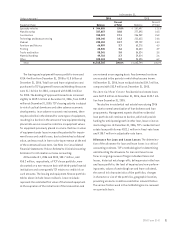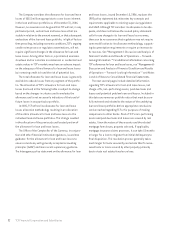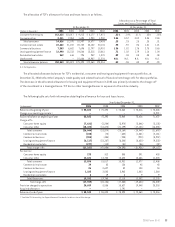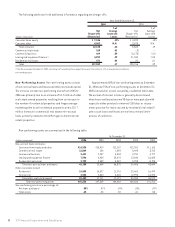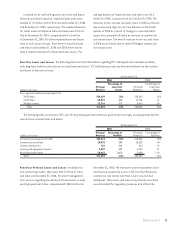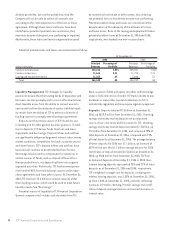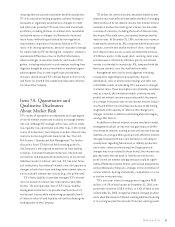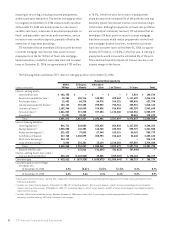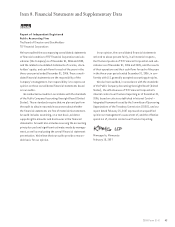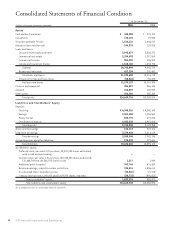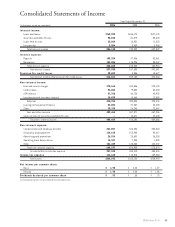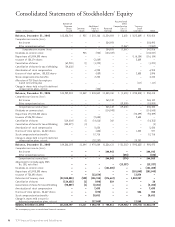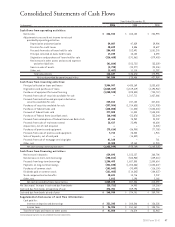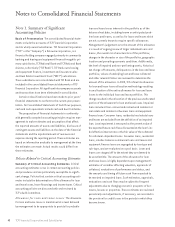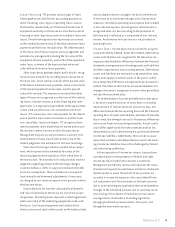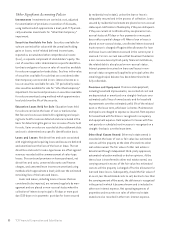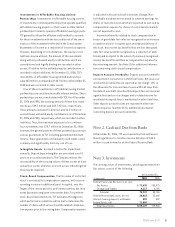TCF Bank 2006 Annual Report Download - page 61
Download and view the complete annual report
Please find page 61 of the 2006 TCF Bank annual report below. You can navigate through the pages in the report by either clicking on the pages listed below, or by using the keyword search tool below to find specific information within the annual report.
reducing interest subsidies and other benefits available to
TCF in its education lending programs; adverse findings in
tax audits or regulatory examinations; changes in credit
and other risks posed by TCF’s loan, lease and investment
portfolios, including declines in commercial or residential
real estate values or changes in allowance for loan and
lease losses methodology dictated by new regulatory
requirements; imposition of vicarious liability on TCF as
lessor in its leasing operations; denial of insurance coverage
for claims made by TCF; technological, computer-related or
operational difficulties or loss or theft of information;
adverse changes in securities markets; and results of liti-
gation, including reductions in card revenues resulting from
litigation brought by various merchants or merchant organi-
zations against Visa; or other significant uncertainties.
Investors should consult TCF’s Annual Report on Form 10-K,
and Forms 10-Q and 8-K for additional important informa-
tion about the Company.
Item 7A. Quantitative and
Qualitative Disclosures
About Market Risk
TCF’s results of operations are dependent to a large degree
on its net interest income and its ability to manage interest-
rate risk. Although TCF manages other risks, such as credit
risk, liquidity risk, operational and other risks, in the normal
course of its business, the Company considers interest-rate
risk to be its most significant market risk. See “Item 1A.
Risk Factors – Operational Risk Management” for further
discussion. Since TCF does not hold a trading portfolio,
the Company is not exposed to market risk from trading
activities. A mismatch between maturities, interest rate
sensitivities and prepayment characteristics of assets and
liabilities results in interest-rate risk. TCF, like most finan-
cial institutions, has material interest-rate risk exposure to
changes in both short-term and long-term interest rates as
well as variable interest rate indices (e.g., the prime rate).
TCF’s Asset/Liability Committee manages TCF’s interest-
rate risk based on interest rate expectations and other
factors. The principal objective of TCF’s asset/liability
management activities is to provide maximum levels of
net interest income while maintaining acceptable levels
of interest-rate risk and liquidity risk and facilitating the
funding needs of the Company.
TCF utilizes net interest income simulation models to esti-
mate the near-term effects (next twelve months) of changing
interest rates on its net interest income. Net interest income
simulation involves forecasting net interest income under
a variety of scenarios, including the level of interest rates,
the shape of the yield curve, and spreads between market
interest rates. At December 31, 2006, net interest income is
estimated to decrease by .8%, compared with the base case
scenario, over the next twelve months if short- and long-
term interest rates were to sustain an immediate increase
of 100 basis points. In the event short- and long-term inter-
est rates were to decline by 100 basis points, net interest
income is estimated to increase by .4%, compared with the
base case scenario, over the next twelve months.
Management exercises its best judgment in making
assumptions regarding loan prepayments, deposit
withdrawals, calls on wholesale borrowings and other non-
controllable events in estimating TCF’s exposure to changes
in interest rates. These assumptions are inherently uncertain
and, as a result, the simulation models cannot precisely
predict net interest income or precisely predict the impact
of a change in interest rates on net interest income. Actual
results will differ from simulated results due to the timing,
magnitude and frequency of interest rate changes and
changes in market conditions and management strategies,
among other factors.
In addition to the net interest income simulation model,
management utilizes an interest rate gap measure (differ-
ence between interest-earning assets and interest-bearing
liabilities re-pricing within a given period). While the interest
rate gap measurement has some limitations, including no
assumptions regarding future asset or liability production
and a static interest rate assumption (large quarterly
changes may occur related to these items), the interest rate
gap represents the net asset or liability sensitivity at a
point in time. An interest rate gap measure could be signifi-
cantly affected by external factors such as loan prepayments,
early withdrawals of deposits, changes in the correlation of
various interest-bearing instruments, competition, or a rise
or decline in interest rates.
TCF’s one-year interest rate gap was a negative $630
million, or 4.3% of total assets at December 31, 2006, com-
pared with a positive $318.4 million, or 2.4% of total assets
at December 31, 2005. A negative interest rate gap position
exists when the amount of interest-bearing liabilities maturing
or re-pricing exceeds the amount of interest-earning assets
41
2006 Form10-K


